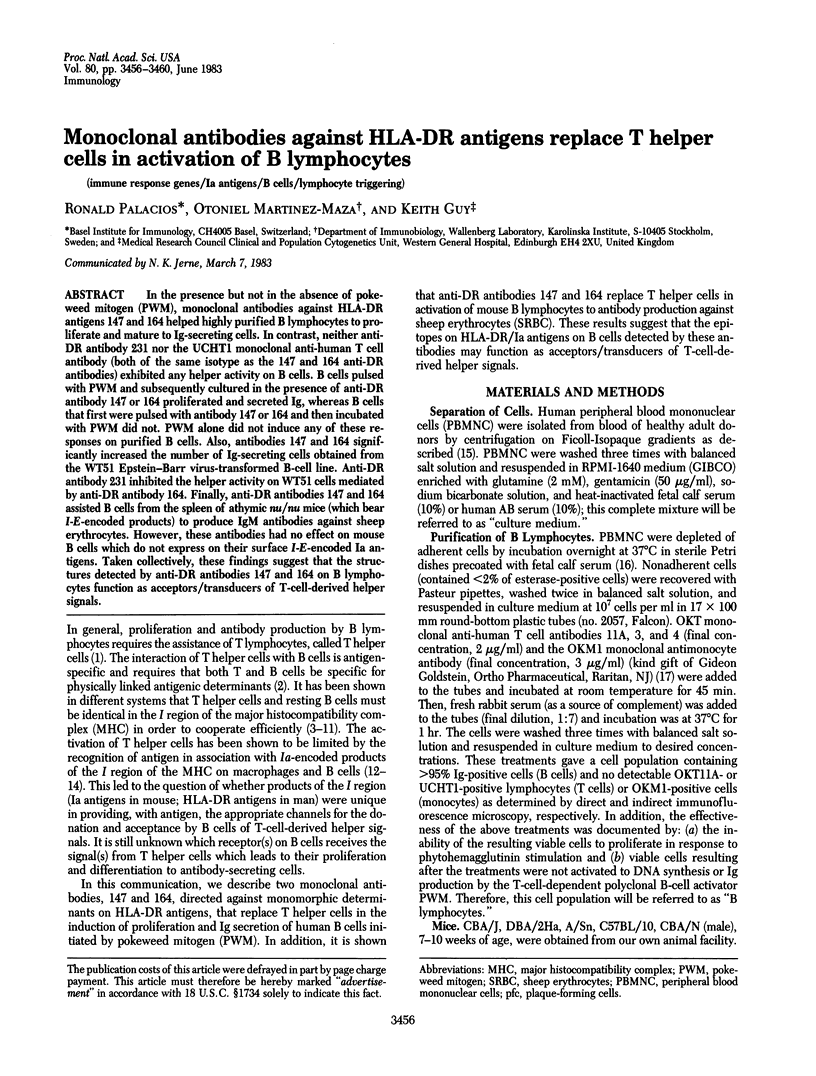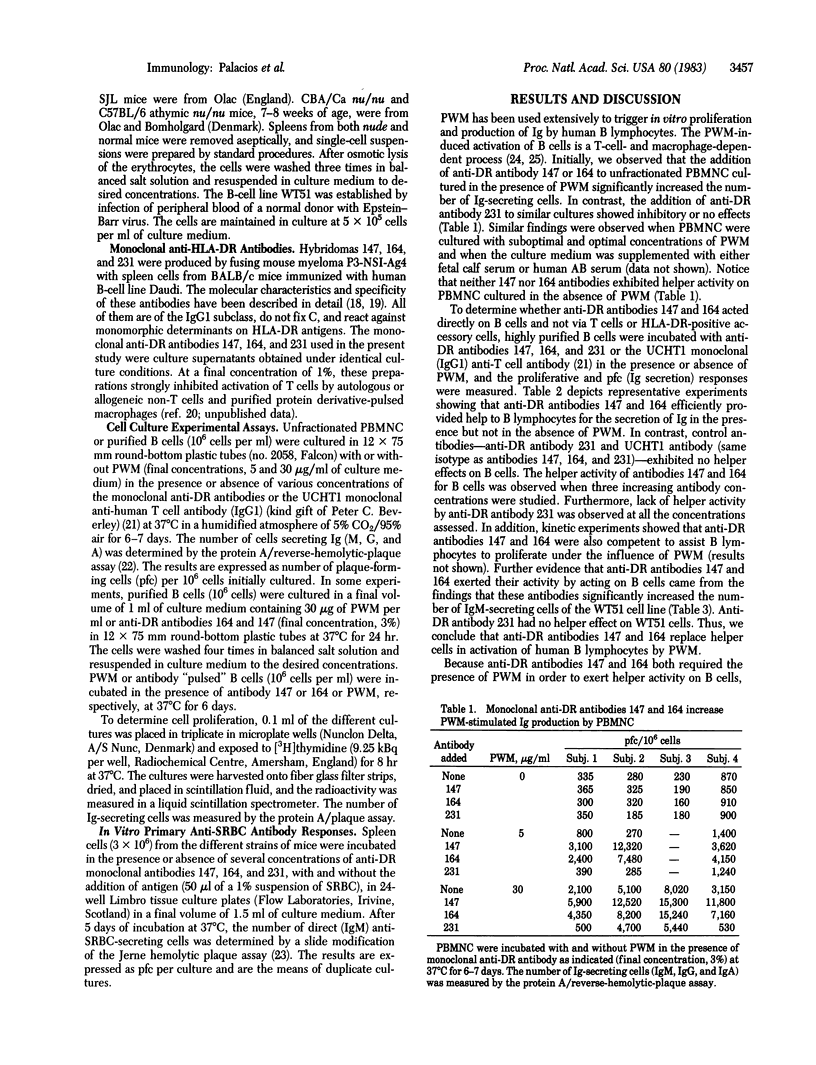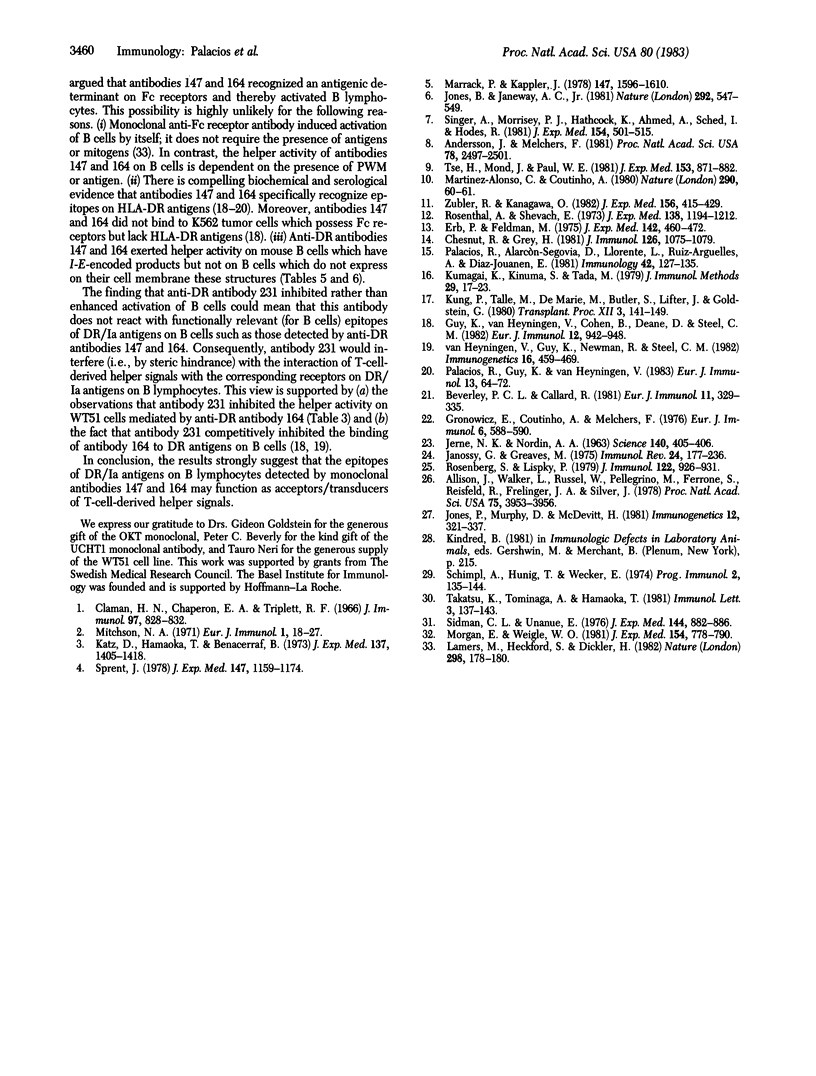Abstract
In the presence but not in the absence of pokeweed mitogen (PWM), monoclonal antibodies against HLA-DR antigens 147 and 164 helped highly purified B lymphocytes to proliferate and mature to Ig-secreting cells. In contrast, neither anti-DR antibody 231 nor the UCHT1 monoclonal anti-human T cell antibody (both of the same isotype as the 147 and 164 anti-DR antibodies) exhibited any helper activity on B cells. B cells pulsed with PWM and subsequently cultured in the presence of anti-DR antibody 147 or 164 proliferated and secreted Ig, whereas B cells that first were pulsed with antibody 147 or 164 and then incubated with PWM did not. PWM alone did not induce any of these responses on purified B cells. Also, antibodies 147 and 164 significantly increased the number of Ig-secreting cells obtained from the WT51 Epstein-Barr virus-transformed B-cell line. Anti-DR antibody 231 inhibited the helper activity on WT51 cells mediated by anti-DR antibody 164. Finally, anti-DR antibodies 147 and 164 assisted B cells from the spleen of athymic nu/nu mice (which bear I-E-encoded products) to produce IgM antibodies against sheep erythrocytes. However, these antibodies had no effect on mouse B cells which do not express on their surface I-E-encoded Ia antigens. Taken collectively, these findings suggest that the structures detected by anti-DR antibodies 147 and 164 on B lymphocytes function as acceptors/transducers of T-cell-derived helper signals.
Full text
PDF




Selected References
These references are in PubMed. This may not be the complete list of references from this article.
- Allison J. P., Walker L. E., Russell W. A., Pellegrino M. A., Ferrone S., Reisfeld R. A., Frelinger J. A., Silver J. Murine Ia and human DR antigens: homology of amino-terminal sequences. Proc Natl Acad Sci U S A. 1978 Aug;75(8):3953–3956. doi: 10.1073/pnas.75.8.3953. [DOI] [PMC free article] [PubMed] [Google Scholar]
- Anderson J., Melchers F. T cell-dependent activation of resting B cells: requirement for both nonspecific unrestricted and antigen-specific Ia-restricted soluble factors. Proc Natl Acad Sci U S A. 1981 Apr;78(4):2497–2501. doi: 10.1073/pnas.78.4.2497. [DOI] [PMC free article] [PubMed] [Google Scholar]
- Beverley P. C., Callard R. E. Distinctive functional characteristics of human "T" lymphocytes defined by E rosetting or a monoclonal anti-T cell antibody. Eur J Immunol. 1981 Apr;11(4):329–334. doi: 10.1002/eji.1830110412. [DOI] [PubMed] [Google Scholar]
- Chesnut R. W., Grey H. M. Studies on the capacity of B cells to serve as antigen-presenting cells. J Immunol. 1981 Mar;126(3):1075–1079. [PubMed] [Google Scholar]
- Claman H. N., Chaperon E. A., Triplett R. F. Immunocompetence of transferred thymus-marrow cell combinations. J Immunol. 1966 Dec;97(6):828–832. [PubMed] [Google Scholar]
- Erb P., Feldmann M. The role of macrophages in the generation of T-helper cells. II. The genetic control of the macrophage-T-cell interaction for helper cell induction with soluble antigens. J Exp Med. 1975 Aug 1;142(2):460–472. doi: 10.1084/jem.142.2.460. [DOI] [PMC free article] [PubMed] [Google Scholar]
- Gronowicz E., Coutinho A., Melchers F. A plaque assay for all cells secreting Ig of a given type or class. Eur J Immunol. 1976 Aug;6(8):588–590. doi: 10.1002/eji.1830060812. [DOI] [PubMed] [Google Scholar]
- Guy K., Van Heyningen V., Cohen B. B., Deane D. L., Steel C. M. Differential expression and serologically distinct subpopulations of human Ia antigens detected with monoclonal antibodies to Ia alpha and beta chains. Eur J Immunol. 1982 Nov;12(11):942–948. doi: 10.1002/eji.1830121109. [DOI] [PubMed] [Google Scholar]
- Janossy G., Greaves M. Functional analysis of murine and human B lymphocyte subsets. Transplant Rev. 1975;24:177–236. doi: 10.1111/j.1600-065x.1975.tb00169.x. [DOI] [PubMed] [Google Scholar]
- Jerne N. K., Nordin A. A. Plaque Formation in Agar by Single Antibody-Producing Cells. Science. 1963 Apr 26;140(3565):405–405. doi: 10.1126/science.140.3565.405. [DOI] [PubMed] [Google Scholar]
- Jones B., Janeway C. A., Jr Cooperative interaction of B lymphocytes with antigen-specific helper T lymphocytes is MHC restricted. Nature. 1981 Aug 6;292(5823):547–549. doi: 10.1038/292547a0. [DOI] [PubMed] [Google Scholar]
- Jones P. P., Murphy D. B., McDevitt H. O. Variable synthesis and expression of E alpha and Ae (E beta) Ia polypeptide chains in mice of different H-2 haplotypes. Immunogenetics. 1981;12(3-4):321–337. doi: 10.1007/BF01561674. [DOI] [PubMed] [Google Scholar]
- Katz D. H., Hamaoka T., Benacerraf B. Cell interactions between histoincompatible T and B lymphocytes. II. Failure of physiologic cooperative interactions between T and B lymphocytes from allogeneic donor strains in humoral response to hapten-protein conjugates. J Exp Med. 1973 Jun 1;137(6):1405–1418. doi: 10.1084/jem.137.6.1405. [DOI] [PMC free article] [PubMed] [Google Scholar]
- Kumagai K., Itoh K., Hinuma S., Tada M. Pretreatment of plastic Petri dishes with fetal calf serum. A simple method for macrophage isolation. J Immunol Methods. 1979;29(1):17–25. doi: 10.1016/0022-1759(79)90121-2. [DOI] [PubMed] [Google Scholar]
- Kung P. C., Talle M. A., DeMaria M. E., Butler M. S., Lifter J., Goldstein G. Strategies for generating monoclonal antibodies defining human t-lymphocyte differentiation antigens. Transplant Proc. 1980 Sep;12(3 Suppl 1):141–146. [PubMed] [Google Scholar]
- Lamers M. C., Heckford S. E., Dickler H. B. Monoclonal anti-Fc IgG receptor antibodies trigger B lymphocyte function. Nature. 1982 Jul 8;298(5870):178–180. doi: 10.1038/298178a0. [DOI] [PubMed] [Google Scholar]
- Marrack P., Kappler J. W. The role of H-2-linked genes in helper T-cell function. III. Expression of immune response genes for trinitrophenyl conjugates of poly-L(Tyr, Glu)-poly-D,L-Ala--poly-L-Lys in B cells and macrophages. J Exp Med. 1978 Jun 1;147(6):1596–1610. doi: 10.1084/jem.147.6.1596. [DOI] [PMC free article] [PubMed] [Google Scholar]
- Morgan E. L., Weigle W. O. Polyclonal activation of human B lymphocytes by Fc fragments. I. Characterization of the cellular requirements for Fc fragment-mediated polyclonal antibody secretion by human peripheral blood B lymphocytes. J Exp Med. 1981 Sep 1;154(3):778–790. doi: 10.1084/jem.154.3.778. [DOI] [PMC free article] [PubMed] [Google Scholar]
- Palacios R., Alarcón-Segovia D., Llorente L., Ruíz-Arguelles A., Díaz-Jouanen E. Human post-thymic precursor cells in health and disease. I. Characterization of the autologous rosette-forming T cells as post-thymic precursors. Immunology. 1981 Jan;42(1):127–135. [PMC free article] [PubMed] [Google Scholar]
- Palacios R., Guy K., Van Heyningen V. Monoclonal antibodies against HLA-DR antigens acting on stimulator cells prevent OKT8+ T lymphocytes from acquiring sensitivity to interleukin 2 and expressing suppressor function. Eur J Immunol. 1983 Jan;13(1):64–72. doi: 10.1002/eji.1830130114. [DOI] [PubMed] [Google Scholar]
- Rosenberg S. A., Lipsky P. E. Monocyte dependence of pokeweed mitogen-induced differentiation of immunoglobulin-secreting cells from human peripheral blood mononuclear cells. J Immunol. 1979 Mar;122(3):926–931. [PubMed] [Google Scholar]
- Rosenthal A. S., Shevach E. M. Function of macrophages in antigen recognition by guinea pig T lymphocytes. I. Requirement for histocompatible macrophages and lymphocytes. J Exp Med. 1973 Nov 1;138(5):1194–1212. doi: 10.1084/jem.138.5.1194. [DOI] [PMC free article] [PubMed] [Google Scholar]
- Sidman C. L., Unanue E. R. Control of B-lymphocyte function. I. Inactivation of mitogenesis by interactions with surface immunoglobulin and Fc-receptor molecules. J Exp Med. 1976 Oct 1;144(4):882–896. doi: 10.1084/jem.144.4.882. [DOI] [PMC free article] [PubMed] [Google Scholar]
- Singer A., Morrissey P. J., Hathcock K. S., Ahmed A., Scher I., Hodes R. J. Role of the major histocompatibility complex in T cell activation of B cell subpopulations Lyb-5+ and Lyb-5- B cell subpopulations differ in their requirement for major histocompatibility complex-restricted T cell recognition. J Exp Med. 1981 Aug 1;154(2):501–516. doi: 10.1084/jem.154.2.501. [DOI] [PMC free article] [PubMed] [Google Scholar]
- Sprent J. Restricted helper function of F1 hybrid T cells positively selected to heterologous erythrocytes in irradiated parental strain mice. II. Evidence for restrictions affecting helper cell induction and T-B collaboration, both mapping to the K-end of the H-2 complex. J Exp Med. 1978 Apr 1;147(4):1159–1174. doi: 10.1084/jem.147.4.1159. [DOI] [PMC free article] [PubMed] [Google Scholar]
- Takatsu K., Tominaga A., Hamaoka T. X-linked recessive inheritance of a defective responsiveness to T-cell-replacing factor in DBA/2Ha mice. Immunol Lett. 1981 Aug;3(3):137–143. doi: 10.1016/0165-2478(81)90116-4. [DOI] [PubMed] [Google Scholar]
- Tse H. Y., Mond J. J., Paul W. E. T lymphocyte-dependent B lymphocyte proliferative response to antigen. I Genetic restriction of the stimulation of B lymphocyte proliferation. J Exp Med. 1981 Apr 1;153(4):871–882. doi: 10.1084/jem.153.4.871. [DOI] [PMC free article] [PubMed] [Google Scholar]
- Zubler R. H., Kanagawa O. Requirement for three signals in B cell responses. II. Analysis of antigen- and Ia-restricted T helper cell-B cell interaction. J Exp Med. 1982 Aug 1;156(2):415–429. doi: 10.1084/jem.156.2.415. [DOI] [PMC free article] [PubMed] [Google Scholar]
- van Heyningen V., Guy K., Newman R., Steel C. M. Human MHC class II molecules as differentiation markers. Immunogenetics. 1982;16(5):459–469. doi: 10.1007/BF00372104. [DOI] [PubMed] [Google Scholar]


